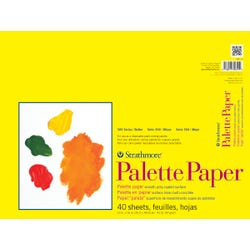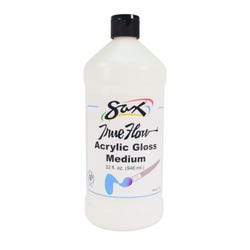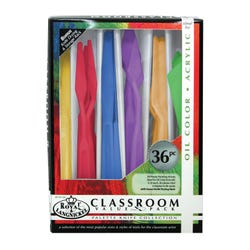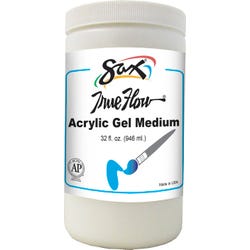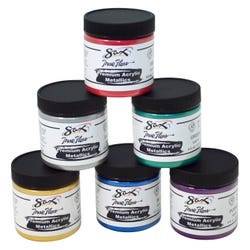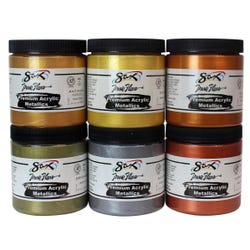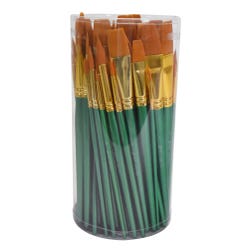Black Mural Canvas Atmospheric Landscapes

Description
Lesson Plan and Artwork by Phyllis M. Annett
Artists throughout history have depicted the landscape around them in various times of day to create a unique quality of light in their work. During the mid nineteenth century the Hudson River School of painters achieved great effects of light in their work by depicting various atmospheric conditions. Learning from these artists, students will achieve atmospheric illusion in a collaborative mural landscape on black canvas.
Objectives
- Students will collaborate, study and create an atmospheric landscape mural by observing the works of others and their own surroundings.
- Students will recognize that Earth Science, and Art History are very much a part of the Visual Arts.
Supplies Needed
Sax® Black Mural Canvas, Individual Size
Sax® Black Mural Canvas, Classroom Size
Sargent Art® Liquid Metal Acrylics, 4 oz. Set of 6
Sargent Art® Liquid Metal Acrylics, 8 oz. Set of 6
Liquitex® Professional Acrylic Ink, Metallic Set of 6
Golden Heavy Gel Medium (Gloss), 8 oz.
Golden Polymer Medium (Gloss), 8 oz.
Reeves Painting Knives, Set of 6
Sax® Optimum Golden Taklon Brushes, 72 Canister Set
Grey Matters Paper Palettes, 9" x 12", 50 Sheets
Sax® Bristilina White Konex Brushes, Size 8 Flat, Each
Sax® Bristilina White Konex Brushes, Size 8 Round, Each
Sax® Bristilina White Konex Brushes, Size 12 Flat, Each
Sax® Bristilina White Konex Brushes, Size 12 Round, Each
*Here are the supplies needed for this lesson plan for reference. Find a convenient carousel of shoppable products for this lesson below.
Standards
CONTENT Standard 1: Generate and conceptualize artistic ideas and work.
CONTENT Standard 2: Organize and develop artistic ideas and work.
CONTENT Standard 3: Define and complete artistic work.
CONTENT Standard 4: Select, analyze and interpret artistic work for presentation.
CONTENT Standard 5: Develop and refine artistic work for presentation.
CONTENT Standard 6: Convey meaning through the presentation of artistic work.
CONTENT Standard 7: Perceive and analyze artistic work.
CONTENT Standard 8: Interpret intent and meaning in artistic work.
CONTENT Standard 10: Synthesize and relate knowledge and personal experiences to make art.
Instructions
1
Gather photos or posters of the Hudson River School of Art Artists depicting their 'Luminism' style of painting which emphasizes a unique quality of light. The Hudson River School of Artists include: Thomas Cole, Frederic Edwin Church, Albert Bierstadt, Asher B. Durand, and Frederick Kensett, who painted in the Hudson River Valley, Catskills, Adirondack and White Mountains of Eastern New York.
With the Student:
2
Show pictures of the Hudson River School of Art's 'Luminism' Style of landscape painting which were painted during the mid nineteenth century.
3
Tell the students that many of these painting were started with very dark surfaces. They focused on a central radiance, darkening its surroundings and created reflected light on the middle distance, leaving the foreground for more sharp detail.
4
Pick paintings that would show the effects of light on the earth in various times of day or atmospheric conditions such as: sunsets, night skies, mist, turbulent clouds, rain, dusk, and dawn.
5
Tell the students that they will be using Metallic Acrylic Paint, Gel Medium and Metallic Inks over Black Mural Canvas to create an Atmospheric Landscape. Stress the fact that they can achieve this goal by emphasizing more atmospheric illusion, rather than depicting extreme detail.
6
Explain and demonstrate how a black canvas will affect the color of paint that is used.
7
Talk about 'Mural' Art work and how it will involve cooperation and collaboration of a group of artist to achieve a particular goal.
8
Give examples of murals in the area, such as those on the outside of buildings that transform a space into something very interesting.
9
Review the basic landscape structure of background, middle ground and foreground. Tell students that their mural can be a cityscape or that of a pastoral setting.
10
Divide the class into 'Mural Teams'. Each team will be responsible for a particular section of the landscape such as background, middle ground, and foreground.
11
Have the students plan and sketch ideas for an Atmospheric Landscape.
12
Have the groups discuss what subjects are in a landscape depending what the scene is about.
13
Have students think about how trees and mountains and foliage are affected in different lighting according to atmospheric conditions.
14
Demonstrate the use of Gel Mediums to enhance the paintings. These will give an illusion of depths and an ethereal mood to the work, as colors are overlaid.
15
Layers of gloss and heavy gel can be applied to give a more effective illusion of depth and light.
16
Use large brushes to lay down the basic colors and smaller ones to suggest detail. Don't get bogged down in tiny detail.
17
Show students different brush techniques to give shadow and form to their work. Stress that the murals are to be a collaborative project recognizing the contribution of each member of the mural team.
18
When all are completed, lead the students into a discussion of each work and how the atmospheric illusions were achieved.



